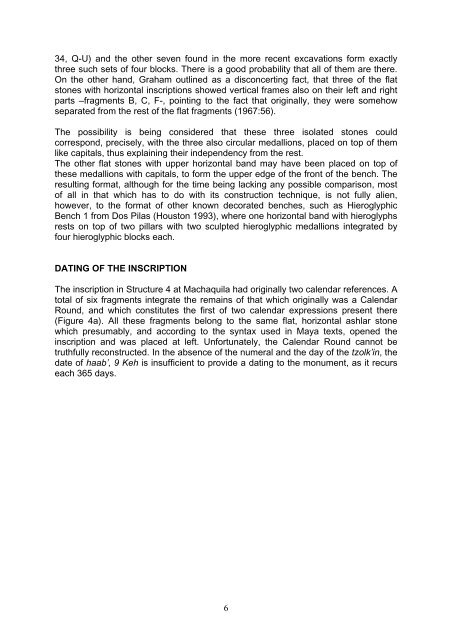63 an epigraphic account related to structure 4 at ... - Famsi
63 an epigraphic account related to structure 4 at ... - Famsi
63 an epigraphic account related to structure 4 at ... - Famsi
You also want an ePaper? Increase the reach of your titles
YUMPU automatically turns print PDFs into web optimized ePapers that Google loves.
34, Q-U) <strong>an</strong>d the other seven found in the more recent excav<strong>at</strong>ions form exactly<br />
three such sets of four blocks. There is a good probability th<strong>at</strong> all of them are there.<br />
On the other h<strong>an</strong>d, Graham outlined as a disconcerting fact, th<strong>at</strong> three of the fl<strong>at</strong><br />
s<strong>to</strong>nes with horizontal inscriptions showed vertical frames also on their left <strong>an</strong>d right<br />
parts –fragments B, C, F-, pointing <strong>to</strong> the fact th<strong>at</strong> originally, they were somehow<br />
separ<strong>at</strong>ed from the rest of the fl<strong>at</strong> fragments (1967:56).<br />
The possibility is being considered th<strong>at</strong> these three isol<strong>at</strong>ed s<strong>to</strong>nes could<br />
correspond, precisely, with the three also circular medallions, placed on <strong>to</strong>p of them<br />
like capitals, thus explaining their independency from the rest.<br />
The other fl<strong>at</strong> s<strong>to</strong>nes with upper horizontal b<strong>an</strong>d may have been placed on <strong>to</strong>p of<br />
these medallions with capitals, <strong>to</strong> form the upper edge of the front of the bench. The<br />
resulting form<strong>at</strong>, although for the time being lacking <strong>an</strong>y possible comparison, most<br />
of all in th<strong>at</strong> which has <strong>to</strong> do with its construction technique, is not fully alien,<br />
however, <strong>to</strong> the form<strong>at</strong> of other known decor<strong>at</strong>ed benches, such as Hieroglyphic<br />
Bench 1 from Dos Pilas (Hous<strong>to</strong>n 1993), where one horizontal b<strong>an</strong>d with hieroglyphs<br />
rests on <strong>to</strong>p of two pillars with two sculpted hieroglyphic medallions integr<strong>at</strong>ed by<br />
four hieroglyphic blocks each.<br />
DATING OF THE INSCRIPTION<br />
The inscription in Structure 4 <strong>at</strong> Machaquila had originally two calendar references. A<br />
<strong>to</strong>tal of six fragments integr<strong>at</strong>e the remains of th<strong>at</strong> which originally was a Calendar<br />
Round, <strong>an</strong>d which constitutes the first of two calendar expressions present there<br />
(Figure 4a). All these fragments belong <strong>to</strong> the same fl<strong>at</strong>, horizontal ashlar s<strong>to</strong>ne<br />
which presumably, <strong>an</strong>d according <strong>to</strong> the syntax used in Maya texts, opened the<br />
inscription <strong>an</strong>d was placed <strong>at</strong> left. Unfortun<strong>at</strong>ely, the Calendar Round c<strong>an</strong>not be<br />
truthfully reconstructed. In the absence of the numeral <strong>an</strong>d the day of the tzolk’in, the<br />
d<strong>at</strong>e of haab’, 9 Keh is insufficient <strong>to</strong> provide a d<strong>at</strong>ing <strong>to</strong> the monument, as it recurs<br />
each 365 days.<br />
6
















